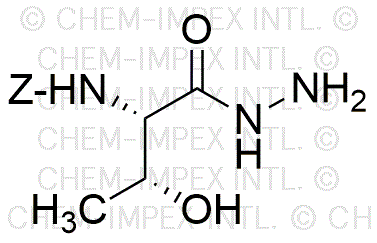Z-L-threonine hydrazide is widely utilized in research focused on:
- Peptide Synthesis: This compound serves as a building block in the synthesis of peptides, particularly in the development of therapeutic agents. Its unique structure allows for the incorporation of hydrazide functionalities that enhance the stability and bioactivity of peptides.
- Drug Development: In pharmaceutical research, Z-L-threonine hydrazide is explored for its potential in creating novel drugs. Its ability to modify biological activity makes it a candidate for designing targeted therapies, especially in oncology.
- Bioconjugation: The compound is used in bioconjugation processes, where it helps in attaching drugs to antibodies or other biomolecules. This application is crucial in developing targeted drug delivery systems, improving the efficacy of treatments.
- Research in Enzyme Inhibition: Researchers utilize Z-L-threonine hydrazide to study enzyme inhibition mechanisms. Its hydrazide group can interact with enzyme active sites, providing insights into enzyme function and potential therapeutic interventions.
- Analytical Chemistry: This chemical is employed in analytical methods to detect and quantify specific biomolecules. Its reactivity can be harnessed in assays, enhancing the sensitivity and specificity of analytical techniques.
General Information
Properties
Safety and Regulations
Applications
Z-L-threonine hydrazide is widely utilized in research focused on:
- Peptide Synthesis: This compound serves as a building block in the synthesis of peptides, particularly in the development of therapeutic agents. Its unique structure allows for the incorporation of hydrazide functionalities that enhance the stability and bioactivity of peptides.
- Drug Development: In pharmaceutical research, Z-L-threonine hydrazide is explored for its potential in creating novel drugs. Its ability to modify biological activity makes it a candidate for designing targeted therapies, especially in oncology.
- Bioconjugation: The compound is used in bioconjugation processes, where it helps in attaching drugs to antibodies or other biomolecules. This application is crucial in developing targeted drug delivery systems, improving the efficacy of treatments.
- Research in Enzyme Inhibition: Researchers utilize Z-L-threonine hydrazide to study enzyme inhibition mechanisms. Its hydrazide group can interact with enzyme active sites, providing insights into enzyme function and potential therapeutic interventions.
- Analytical Chemistry: This chemical is employed in analytical methods to detect and quantify specific biomolecules. Its reactivity can be harnessed in assays, enhancing the sensitivity and specificity of analytical techniques.
Documents
Safety Data Sheets (SDS)
The SDS provides comprehensive safety information on handling, storage, and disposal of the product.
Product Specification (PS)
The PS provides a comprehensive breakdown of the product’s properties, including chemical composition, physical state, purity, and storage requirements. It also details acceptable quality ranges and the product's intended applications.
Certificates of Analysis (COA)
Search for Certificates of Analysis (COA) by entering the products Lot Number. Lot and Batch Numbers can be found on a product’s label following the words ‘Lot’ or ‘Batch’.
Número de catálogo
Número de lote/lote
Certificates Of Origin (COO)
This COO confirms the country where the product was manufactured, and also details the materials and components used in it and whether it is derived from natural, synthetic, or other specific sources. This certificate may be required for customs, trade, and regulatory compliance.
Número de catálogo
Número de lote/lote
Safety Data Sheets (SDS)
The SDS provides comprehensive safety information on handling, storage, and disposal of the product.
DownloadProduct Specification (PS)
The PS provides a comprehensive breakdown of the product’s properties, including chemical composition, physical state, purity, and storage requirements. It also details acceptable quality ranges and the product's intended applications.
DownloadCertificates of Analysis (COA)
Search for Certificates of Analysis (COA) by entering the products Lot Number. Lot and Batch Numbers can be found on a product’s label following the words ‘Lot’ or ‘Batch’.
Número de catálogo
Número de lote/lote
Certificates Of Origin (COO)
This COO confirms the country where the product was manufactured, and also details the materials and components used in it and whether it is derived from natural, synthetic, or other specific sources. This certificate may be required for customs, trade, and regulatory compliance.


